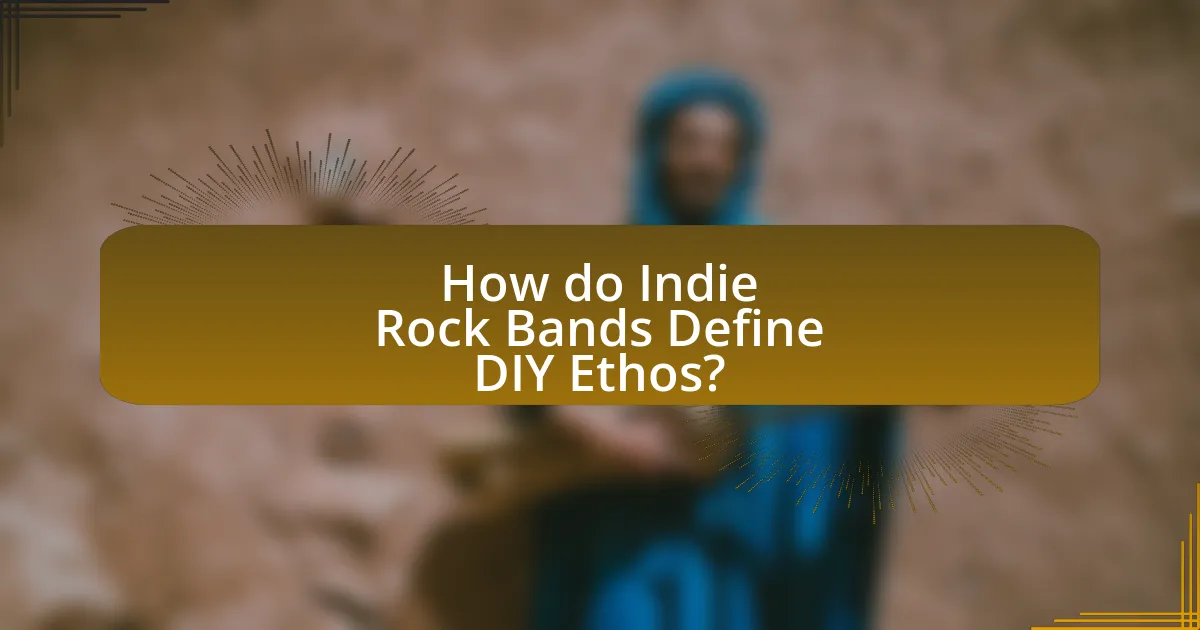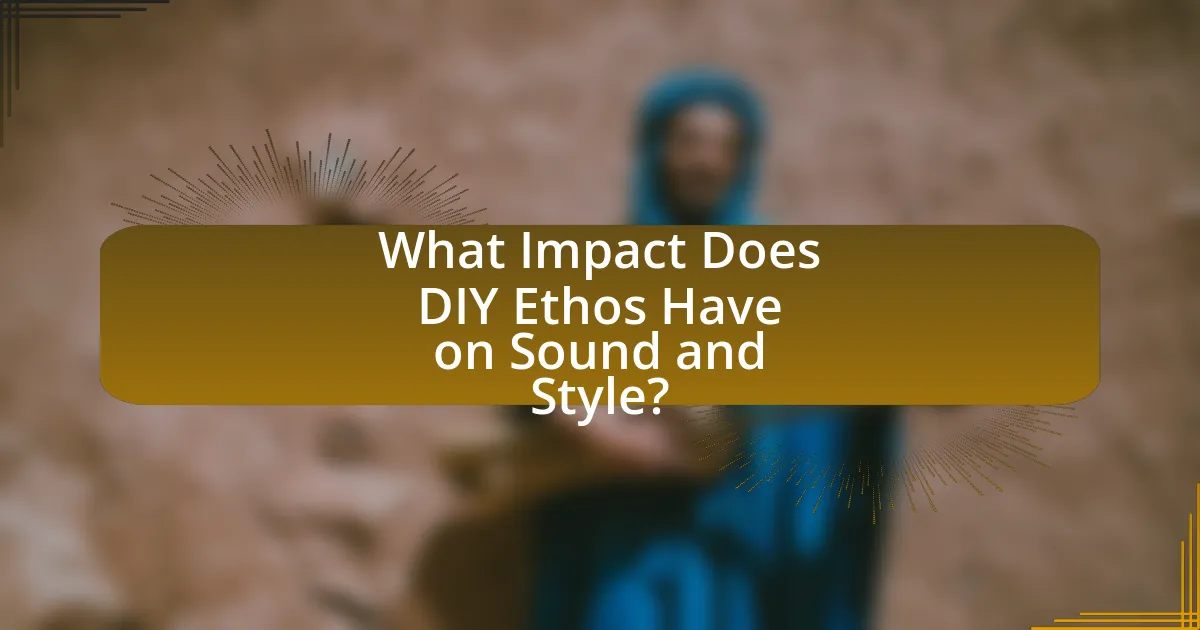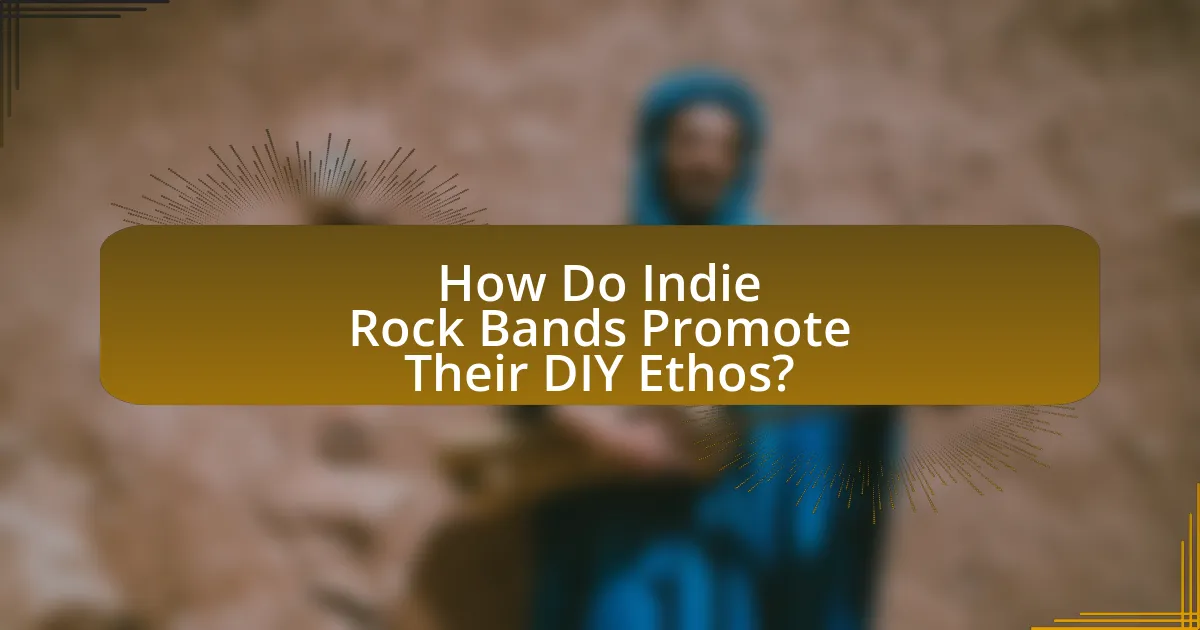The article examines how indie rock bands utilize a DIY ethos to shape their sound and artistic identity. It defines DIY ethos as a commitment to self-sufficiency in music production, distribution, and promotion, emphasizing artistic control and authenticity. Key principles include self-sufficiency, artistic freedom, and community engagement, which contrast with traditional music industry practices. The article also explores the impact of DIY recording techniques on sound, the importance of grassroots marketing strategies, and the role of community support in fostering a vibrant indie music culture. Additionally, it highlights best practices for aspiring indie rock bands to effectively implement a DIY approach in their careers.

How do Indie Rock Bands Define DIY Ethos?
Indie rock bands define DIY ethos as a commitment to self-sufficiency in music production, distribution, and promotion. This approach emphasizes artistic control, allowing bands to create music that reflects their authentic vision without corporate interference. For instance, many indie bands record their albums in home studios or small local studios, often using affordable equipment, which fosters a unique sound that distinguishes them from mainstream artists. The DIY ethos is also evident in their reliance on grassroots marketing strategies, such as social media promotion and local shows, which helps build a loyal fanbase. This self-directed model has been validated by the success of numerous indie bands, such as Death Cab for Cutie and The Decemberists, who have thrived outside major label systems while maintaining their artistic integrity.
What are the core principles of DIY ethos in music?
The core principles of DIY ethos in music include self-sufficiency, artistic freedom, and community engagement. Self-sufficiency emphasizes the importance of artists taking control over their creative processes, production, and distribution, often leading to the creation of independent record labels and self-released albums. Artistic freedom allows musicians to explore their unique sounds without commercial constraints, fostering innovation and authenticity. Community engagement highlights the significance of collaboration and support among artists, fans, and local scenes, which is essential for sustaining independent music culture. These principles have been historically validated by movements such as punk rock in the 1970s, where bands like The Ramones and The Sex Pistols exemplified the DIY approach by producing their music outside of major label systems.
How does DIY ethos differ from traditional music industry practices?
DIY ethos emphasizes self-production and independence in music creation, contrasting sharply with traditional music industry practices that rely on major labels for funding, marketing, and distribution. In the DIY approach, artists retain creative control and often utilize digital platforms for direct engagement with their audience, bypassing intermediaries. This shift is evidenced by the rise of independent labels and artists who leverage social media and streaming services, allowing them to reach listeners without the constraints of traditional contracts. For instance, Bandcamp and SoundCloud have enabled countless musicians to distribute their work directly, reflecting a significant departure from the conventional model where record labels dictated artistic direction and promotional strategies.
Why is DIY ethos important for indie rock bands?
DIY ethos is important for indie rock bands because it empowers them to maintain creative control and authenticity in their music. This approach allows bands to produce, distribute, and promote their work independently, fostering a unique sound that reflects their artistic vision. Historically, many successful indie rock bands, such as Sonic Youth and The White Stripes, have thrived under this model, demonstrating that self-reliance can lead to both critical and commercial success. By embracing DIY principles, indie rock bands can cultivate a loyal fanbase and navigate the music industry on their own terms, ultimately shaping their sound and identity.
How does DIY ethos influence the creative process?
DIY ethos significantly influences the creative process by promoting self-sufficiency and artistic freedom among creators. This approach encourages individuals to take control of their projects, leading to innovative and unique expressions that reflect personal vision rather than commercial constraints. For instance, many indie rock bands utilize DIY methods to record, produce, and distribute their music, allowing them to experiment with sound and style without the limitations imposed by major labels. This has been evidenced by the rise of home studios and independent labels, which have empowered artists to maintain creative integrity while reaching audiences directly.
What role does self-production play in shaping sound?
Self-production plays a crucial role in shaping sound by allowing artists to have complete creative control over their music. This autonomy enables indie rock bands to experiment with different styles, techniques, and production methods that reflect their unique artistic vision. For instance, bands like Death Cab for Cutie and The Black Keys have utilized self-production to create distinct sounds that resonate with their personal experiences and artistic intentions. The ability to self-produce also often leads to a more authentic sound, as artists can bypass commercial pressures and industry standards, resulting in music that is true to their identity.
How do indie rock bands approach songwriting with a DIY mindset?
Indie rock bands approach songwriting with a DIY mindset by prioritizing authenticity and creative freedom over commercial constraints. This approach often involves self-producing their music, writing lyrics that reflect personal experiences, and experimenting with unconventional song structures. For instance, many indie bands utilize home recording equipment and software, allowing them to maintain control over their sound and artistic vision without the influence of major record labels. This method has been validated by the success of bands like Death Cab for Cutie and Bon Iver, who began their careers with minimal resources and achieved critical acclaim through their unique, self-directed songwriting processes.

What Impact Does DIY Ethos Have on Sound and Style?
The DIY ethos significantly impacts sound and style by promoting authenticity and experimentation in music production. Indie rock bands often embrace this ethos to create unique sonic identities, allowing them to bypass traditional industry constraints. For instance, bands like Sonic Youth and The White Stripes utilized home recording techniques and unconventional instrumentation, resulting in distinctive sounds that reflect their artistic vision. This approach fosters a raw, unpolished aesthetic that resonates with audiences seeking genuine expression, as evidenced by the rise of lo-fi recordings in the genre. The DIY ethos thus empowers artists to innovate and connect with listeners on a deeper level, shaping the overall landscape of indie rock music.
How does DIY recording affect the final sound of indie rock music?
DIY recording significantly influences the final sound of indie rock music by allowing artists to maintain creative control and experiment with unconventional techniques. This autonomy leads to a raw, authentic sound that often reflects the band’s unique identity, as seen in albums like “In the Aeroplane Over the Sea” by Neutral Milk Hotel, which was recorded in a home setting and features lo-fi production elements. The use of affordable recording technology enables musicians to capture spontaneous performances and incorporate diverse sounds, resulting in a distinctive sonic texture that is characteristic of the indie rock genre.
What are the common techniques used in DIY recording?
Common techniques used in DIY recording include multitracking, home studio setups, and the use of digital audio workstations (DAWs). Multitracking allows musicians to record multiple audio tracks separately, enabling greater control over the final mix. Home studio setups often utilize affordable equipment such as microphones, audio interfaces, and monitors, making recording accessible to indie rock bands. Digital audio workstations, like Ableton Live or GarageBand, provide intuitive interfaces for editing and mixing, facilitating the creative process. These techniques empower artists to produce high-quality recordings independently, reflecting their unique sound and artistic vision.
How do production choices reflect the band’s identity?
Production choices reflect the band’s identity by showcasing their artistic values, influences, and commitment to authenticity. For instance, many indie rock bands opt for lo-fi production techniques to emphasize rawness and emotional honesty, aligning with the DIY ethos that prioritizes creativity over commercial polish. This approach often results in a sound that is distinctively personal and reflective of the band’s unique experiences and perspectives. Additionally, the use of unconventional recording methods, such as home studios or live takes, further illustrates a rejection of mainstream industry standards, reinforcing the band’s identity as independent and innovative.
Why do indie rock bands choose unconventional instruments or sounds?
Indie rock bands choose unconventional instruments or sounds to differentiate themselves and express their artistic identity. This choice allows them to break away from mainstream music conventions, fostering creativity and innovation in their sound. For instance, bands like Arcade Fire and Sufjan Stevens have incorporated instruments such as the hurdy-gurdy and banjo, which not only enrich their musical texture but also reflect a commitment to a DIY ethos that values originality over commercial appeal. This approach has been supported by the rise of home recording technology, enabling artists to experiment with diverse sounds without the constraints of traditional studio environments.
What influences lead to experimentation in sound?
Experimentation in sound is primarily influenced by the DIY ethos prevalent in indie rock culture. This ethos encourages musicians to explore unconventional techniques, instruments, and production methods, often leading to innovative soundscapes. For instance, many indie rock bands utilize home recording equipment and software, allowing them to manipulate sound in ways that traditional studio environments may not permit. Additionally, the influence of diverse musical genres and cultural movements inspires artists to blend styles, resulting in unique auditory experiences. Historical examples include bands like Sonic Youth and Radiohead, who have pushed sonic boundaries by incorporating elements from noise rock and electronic music, respectively, demonstrating that the DIY approach fosters a fertile ground for sonic experimentation.
How does the use of non-traditional instruments shape the band’s style?
The use of non-traditional instruments significantly shapes a band’s style by introducing unique textures and sounds that differentiate their music from mainstream genres. For instance, indie rock bands often incorporate instruments like banjos, ukuleles, or synthesizers, which can create a distinct sonic identity. This approach allows bands to experiment with unconventional melodies and rhythms, fostering creativity and innovation in their compositions. A notable example is the band Arcade Fire, which utilizes a range of instruments, including the hurdy-gurdy and accordion, to enhance their eclectic sound. This incorporation of diverse instruments not only enriches the musical landscape but also aligns with the DIY ethos prevalent in indie rock, encouraging artists to break away from traditional norms and explore new artistic avenues.

How Do Indie Rock Bands Promote Their DIY Ethos?
Indie rock bands promote their DIY ethos primarily through self-production, grassroots marketing, and community engagement. By recording their music independently, these bands maintain creative control and authenticity, which is a core aspect of the DIY philosophy. For instance, many indie bands utilize home studios or local recording facilities to produce their albums, allowing them to craft their sound without the constraints of major label expectations.
Additionally, they often rely on social media platforms and local shows to connect directly with their audience, bypassing traditional marketing channels. This approach not only fosters a sense of community but also encourages fan involvement, as seen in initiatives like crowdfunding campaigns for album releases. The success of bands like Death Cab for Cutie and The Decemberists, who started with DIY methods and built substantial followings, exemplifies how effective these strategies can be in promoting a DIY ethos.
What strategies do indie rock bands use for self-promotion?
Indie rock bands use a variety of self-promotion strategies, including social media engagement, live performances, and collaborations with other artists. Social media platforms like Instagram, Twitter, and Facebook allow bands to connect directly with fans, share updates, and promote new music. Live performances, often in local venues or festivals, help build a grassroots following and create word-of-mouth buzz. Collaborations with other musicians can expand their audience and introduce their music to new listeners. According to a 2021 survey by the Music Industry Research Association, 70% of independent artists reported that social media was their primary tool for promotion, highlighting its effectiveness in reaching audiences.
How do social media platforms enhance DIY promotion?
Social media platforms enhance DIY promotion by providing indie rock bands with accessible tools to reach a wider audience without traditional marketing costs. These platforms allow artists to share their music, engage with fans, and build a community around their brand. For instance, according to a 2021 report by the International Federation of the Phonographic Industry, 79% of music consumers discover new music through social media, highlighting its effectiveness in promoting DIY artists. Additionally, platforms like Instagram and TikTok enable bands to create visually engaging content that can go viral, further amplifying their reach and visibility in a competitive market.
What role do live performances play in building a fanbase?
Live performances are crucial for building a fanbase as they create direct, personal connections between artists and audiences. These events allow indie rock bands to showcase their unique sound and energy, fostering an intimate atmosphere that encourages audience engagement. According to a study by the University of Southern California, 70% of concertgoers reported feeling a stronger connection to artists after attending live shows, highlighting the impact of these performances on fan loyalty. Additionally, live performances often lead to word-of-mouth promotion, as attendees share their experiences with friends and on social media, further expanding the band’s reach and visibility.
How does community support influence the DIY approach?
Community support significantly enhances the DIY approach by providing resources, encouragement, and collaboration opportunities for indie rock bands. This support fosters a sense of belonging and motivation, enabling artists to experiment and innovate without the constraints of traditional music industry pressures. For instance, local music scenes often offer platforms for performances, access to shared equipment, and networking opportunities, which are crucial for emerging artists. Research indicates that bands with strong community ties are more likely to succeed in self-releasing music and organizing events, as they can leverage local audiences and resources effectively.
What are the benefits of collaborating with other indie artists?
Collaborating with other indie artists enhances creativity and expands audience reach. When indie artists work together, they combine diverse influences and skills, leading to innovative soundscapes that can attract listeners from different musical backgrounds. For instance, a study by the University of Southern California found that collaboration in music often results in higher-quality outputs, as artists can share resources and ideas, ultimately enriching their artistic expression. Additionally, partnerships can lead to cross-promotion, where each artist introduces their fan base to the other’s work, significantly increasing visibility and potential sales.
How do local music scenes foster a DIY culture?
Local music scenes foster a DIY culture by providing accessible platforms for artists to create, perform, and distribute their music independently. These scenes often consist of small venues, community spaces, and local collectives that encourage musicians to collaborate and share resources, reducing reliance on traditional music industry structures. For example, the rise of house shows and community festivals allows artists to connect directly with audiences, facilitating grassroots promotion and support. Additionally, local music scenes often emphasize collaboration over competition, leading to a supportive environment where musicians can experiment and innovate without the constraints of commercial pressures. This collaborative spirit is evident in the proliferation of independent record labels and artist collectives that prioritize artistic freedom and community engagement, further solidifying the DIY ethos within these local scenes.
What are some best practices for aspiring indie rock bands?
Aspiring indie rock bands should focus on developing a unique sound, engaging with their audience, and utilizing social media for promotion. Establishing a distinctive musical identity helps bands stand out in a crowded market, as seen with successful indie acts like Arctic Monkeys, who gained popularity through their unique blend of rock and catchy melodies. Engaging with fans through live performances and personal interactions fosters a loyal following, which is crucial for indie bands, as evidenced by the grassroots success of bands like The Lumineers. Additionally, leveraging social media platforms allows bands to reach wider audiences without significant financial investment, a strategy effectively used by many indie artists to build their brand and share their music.
How can new bands effectively implement a DIY ethos?
New bands can effectively implement a DIY ethos by taking control of their music production, distribution, and promotion processes. This involves recording music independently, often using affordable home studio equipment or software, which allows for creative freedom and cost savings. Additionally, bands can distribute their music through platforms like Bandcamp or SoundCloud, bypassing traditional record labels. Promotion can be achieved through social media channels, local gigs, and grassroots marketing strategies, fostering a direct connection with their audience. Historical examples include bands like The Velvet Underground and Sonic Youth, who utilized DIY methods to cultivate their unique sounds and maintain artistic integrity.
What resources are available for DIY musicians today?
DIY musicians today have access to a variety of resources including digital distribution platforms, social media marketing tools, and online collaboration software. Digital distribution platforms like DistroKid and TuneCore allow musicians to release their music on major streaming services without the need for a record label. Social media platforms such as Instagram and TikTok provide avenues for marketing and audience engagement, enabling artists to build their fanbase organically. Additionally, online collaboration tools like BandLab and Soundtrap facilitate remote music creation and production, allowing musicians to work together regardless of location. These resources empower DIY musicians to take control of their careers and reach wider audiences independently.
